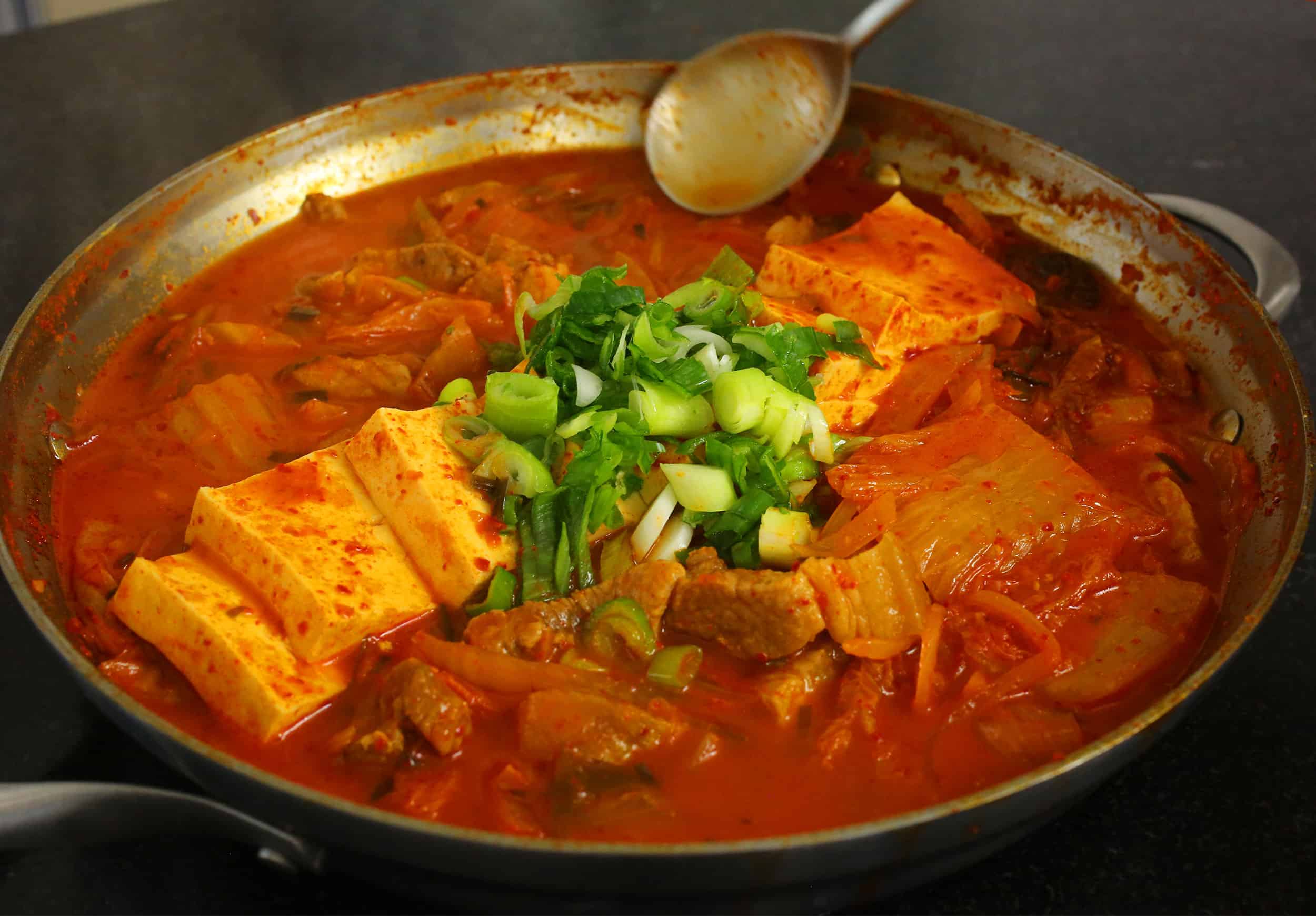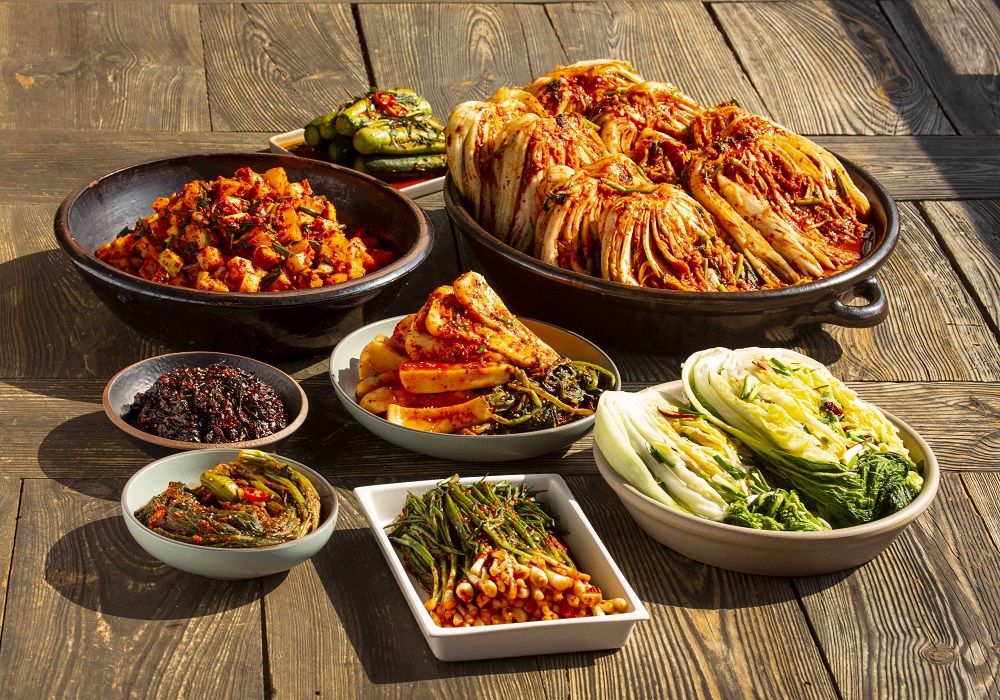
This week and next week, we're heading to the kitchen!
We'll be working through a 김치찌개 recipe from the OG himself: 백종원!
If you've watched the culinary class wars on Netflix, you probably know him.

Anyways, on his YouTube channel, he has recipes for quite a lot of very common Korean dishes, my favorite of which is 김치찌개. Here's a link to the YouTube video if you'd like to take a look: Link
I really encourage you to try and cook this recipe! While there are many ingredients, just the 3 of kimchi, pork, and water can still make a killer stew. While cooking, try to practice each of the ingredient names as well as the phrases for cooking each step. Here's what 김치찌개 looks like when it's done!
 (From Maangchi's recipe, another OG Korean cooking YouTuber)
(From Maangchi's recipe, another OG Korean cooking YouTuber)
Today's newsletter is part 1 of 2, where today we will focus just on the ingredients their words, and words that can spin off of them.
Next week, we'll tackle the cooking instructions. Let's dive in!
Ingredients ✅
Below is a snapshot from the video:

First things first: the name of the dish is 돼지고기 김치찌개.
돼지고기 = pig (돼지) + meat (고기) = pork
김치찌개 = 김치 (kimchi) + 찌개 (stew)
So, this is a pork kimchi stew: pretty spot on!
Quick aside about kimchi 🥬

- Kimchi is more of a preservation technique via fermentation rather than any specific type of kimchi
- There are over 100 recognized types of kimchi in Korea, but a lot of times when someone refers to kimchi, they are probably referring to 배추 김치, which is made from cabbage.
- For this recipe, a nice and sour (discussed later) cabbage kimchi is recommended.
Let's work our way through the ingredients:
- 🥓 돼지고기(목살) 1컵 = 돼지고기 (pork, explained above) + 목살 (neck + meat) + 1 컵 (1 cup)
- 목 (neck or throat) offers a lot of quick additional words, pretty much for free. For example:
- 손목 = hand + throat = wrist
- 발목 = foot + throat = wrist
- 목말라 = throat + dry (마르다) = thirsty
- 목 (neck or throat) offers a lot of quick additional words, pretty much for free. For example:
- 🥬 신 김치 = 신(descriptive form of 시다 (sour) = 시다 + 은 = 신) + 김치 (you know this one by now) = sour kimchi (it's preferred to use sour kimchi that has fermented for a while for soups and stews. It has more flavor that can impart upon the stew)
- 💧물 = water
- 🌶️ 청양고추 = 청양(a county in South Korea) + 고추 (pepper) + 2개 (2 of them)
- -개 is a unit noun that is specific for what is being counted. -개 is a bit of a catch-all for counting for things (non-living). Counting unit nouns are an extensive topic and require a whole newsletter or two for just them. So, we're gonna leave it at that for now!
- Also, this type of pepper is actually pretty spicy! So, specifying the pepper as 청양고추 also implies that the recipe calls for a spicy pepper.
- 🌿 대파 약 2/3대= 대파 (green onion) + 약 2/3대 (about 2/3rds)
- 약 is versatile to say "about" something.
- For example, one of the main places you might hear it is if you have Naver Maps running and you'll hear: 약 삼백 미터 후 좌회전하세요 (take a left in about 300 meters)
- 대 is another counting noun —again we're not gonna get into it in this newsletter (so many of them!)
- 🧄 간 마늘 1큰술 = 간 (descriptive form of 갈다, to grind) + 마늘 (garlic) + 1큰술 (descriptive form of big (크다) and spoon = tablespoon)
- 🌶️ 굵은 고춧가루= 굵은 (descriptive form of to be thick (굵다), in this case means large) + 고춧가루 (고추 (chili pepper) + 가루 (flakes))
- If you're like me, you're probably like "Hey, you wrote 고추 with an extra ㅅ. It was just 고추 before. What the heck?" Great point! The extra ㅅ here is called the 사이시옷 and it helps with the pronunciation of the word.
- When there are two nouns that are combined to make a new noun and the first noun ends in a vowel, most of the time, you'll use the 사이시옷.
- In this case, 고춧가루 should be pronounced more like 고추까루, with a stronger ㄲ sound. Here are a few more examples:
- 나뭇가지[pronounced 나무까지] = 나무 (tree) + 가지 (branch)
- 바닷가[pronounced 바다까] = 바다 (sea) + 가 (side)
- 빗물 [pronounced 빈물] = 비 (rain) + 물 (water)
- There are A LOT of exceptions to this rule, but it's a good place to start!
- 🌶️ 고운 고춧가루=고운(descriptive form of 곱다 (beautiful), which conjugates irregularly) +고춧가루 (same as before) = fine red pepper flakes
- 🍲 국간장=국 (soup) +간장 (soy sauce), which is soy sauce specifically for making soups, saltier than the ones we use for sushi and the like
- 🦐 새우젓= 새우(shrimp) +젓 (salty, preserved raw protein, usually some kind of seafood)
Phew! That was a lot. Next week we'll get to tackling the instructions. I sincerely hope you give cooking it a try, it may take a bit of time, but it's SO worth it.
If you made it this far, thanks!
Every Sunday, we write about a topic, whether it is news, K-dramas, music, travel, daily life, etc. — all through the lens of the Korean language. If you know others interested in the Korean language or culture, please share it around!
If you have a topic that you think would be interesting to learn about, please let us know! Also, we'd love to learn more about how these emails help you in your Korean language journey.
